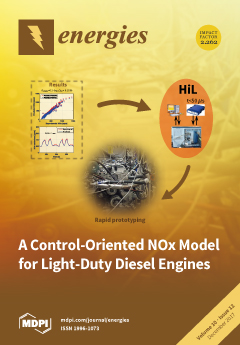Cachaza is a type of non-centrifugal sugarcane press-mud that, if it is not employed efficiently, generates water pollution, soil eutrophication, and the spread of possible pathogens. This biomass can be fermented to produce bioethanol. Our intention is to obtain bioethanol that can be
[...] Read more.
Cachaza is a type of non-centrifugal sugarcane press-mud that, if it is not employed efficiently, generates water pollution, soil eutrophication, and the spread of possible pathogens. This biomass can be fermented to produce bioethanol. Our intention is to obtain bioethanol that can be catalytically reformed to produce hydrogen (H
2) for further use in fuel cells for electricity production. However, some impurities could negatively affect the catalyst performance during the bioethanol reforming process. Hence, the aim of this study was to assess the fermentation of
Cachaza using ammonium sulfate ((NH
4)
2SO
4) loadings and
Saccharomyces cerevisiae strain to produce the highest ethanol concentration with the minimum amount of impurities in anticipation of facilitating further bioethanol purification and reforming for H
2 production. The results showed that ethanol production from
Cachaza fermentation was about 50 g·L
−1 and the (NH
4)
2SO
4 addition did not affect its production. However, it significantly reduced the production of branched alcohols. When a 160 mg·L
−1 (NH
4)
2SO
4 was added to the fermentation culture, 2-methyl-1-propanol was reduced by 41% and 3-methyl-1-butanol was reduced by 6%, probably due to the repression of the catabolic nitrogen mechanism. Conversely, 1-propanol doubled its concentration likely due to the higher threonine synthesis promoted by the reducing sugar presence. Afterwards, we employed the modified Gompertz model to fit the ethanol, 2M1P, 3M1B, and 1-propanol production, which provided acceptable fits (
R2 > 0.881) for the tested compounds during
Cachaza fermentation. To the best of our knowledge, there are no reports of the modelling of aliphatic production during fermentation; this model will be employed to calculate yields with further scaling and for life cycle assessment.
Full article





